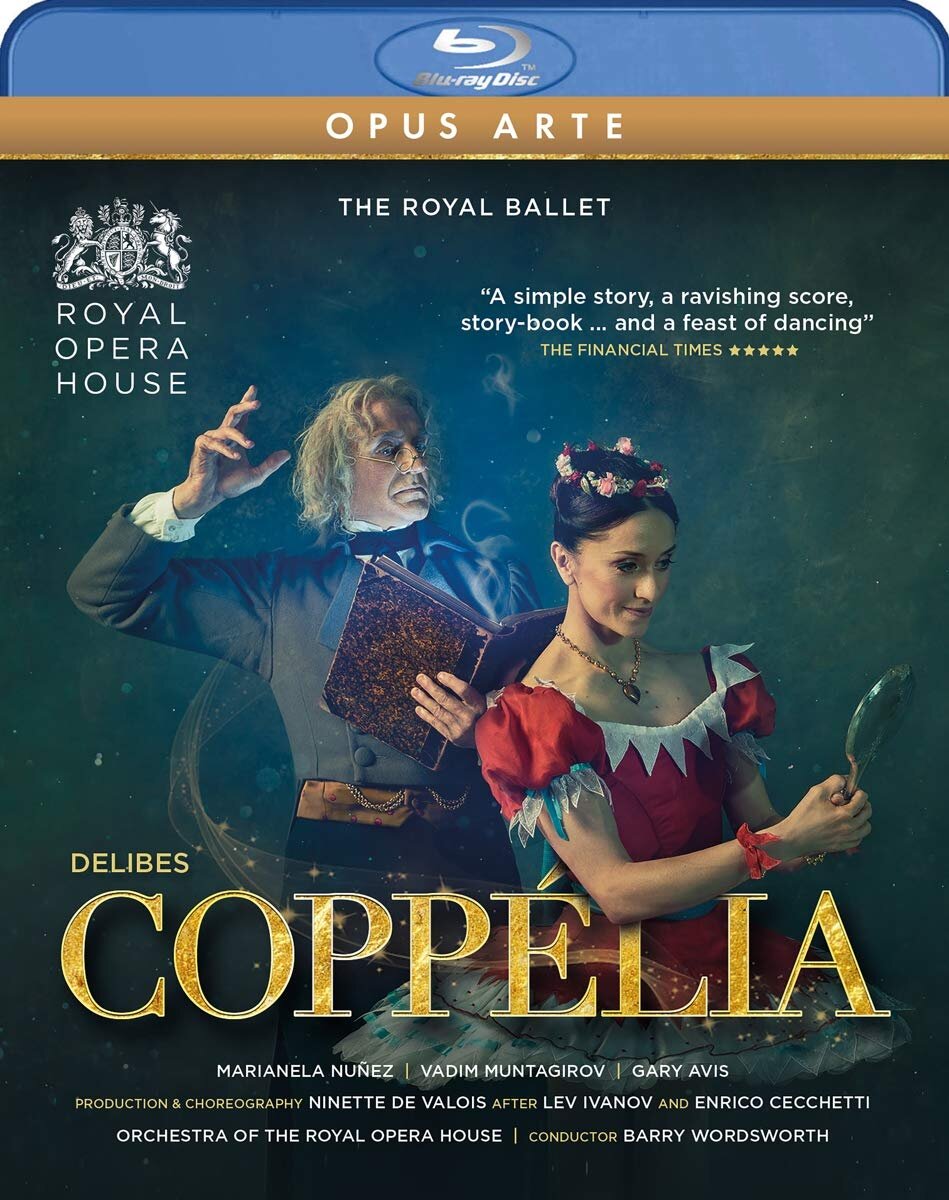

Coppélia ballet. Music by Léo Delibes. Libretto by Charles Nuitter and Arthur Saint-Léon after E.T.A. Hoffmann. Choreography and production by Ninette de Valois after Lev Ivanov and Enrico Cecchetti. Recorded 2019 at the Royal Opera House. Stars Marianela Nuñez (Swanilda), Vadim Muntagirov (Franz), Gary Avis (Dr. Coppélius), Ashley Dean (Coppélia), Christopher Saunders (The Burgomaster), Enrico Montes (The Innkeeper), Mayara Magri (Peasant Girl), Lukas Bjørneboe Brændsrød (The Duke), Claire Calvert (Aurora), and Annette Buvoli (Prayer). Barry Wordsworth conducts the Orchestra of the Royal Opera House. Designs by Osbert Lancaster; lighting design by John B. Read; staging by Christopher Carr. Directed for TV by Ross MacGibbon. Released 2020, disc has 5.1 HD Master Audio sound. Grade: A-
We already have an A+ version of the traditional Coppélia from the Bolshoi Ballet. Now the ROB weighs in with a competing take. See our Bolshoi review for general information about this story. In this review we will try to stack up the London show against the Moscow juggernaut.
In our first screenshot below, the sets and costumes in London look simplified and border on cartoonist when compared to the more lavish designs in the Moscow show:
Next below is Ashley Dean as Coppélia sitting in a window (of the house of the mysterious Dr. Coppélias) overlooking the town plaza. This must be the easiest role to learn in all ballet:
The harvest is over and it’s time for bonuses and weddings. Front left below is Swanilda (Mariana Nuñez) and front right is her sweetheart Franz (Vadim Muntagirov). Swanilda is irritated with Franz because he has been paying too much attention to the girl in the window. The burgomaster (Christopher Saunders) is trying to patch things up. Swanilda and Franz are the best dancers in the village and the wedding day will be a flop if they don’t get hitched with the other eager couples. The city square scenes throughout are brightly lit and the cameras often produce a faded or bleached-out look that you can see here in the faces of both Swanilda and Franz:
Later that evening, Swanilda and the village girls find gain entrance to the house of Dr. Coppelius while he is drinking at the tavern. They want to confront the girl who is causing all the trouble. Always the ring-leader, Swanilda braves a closer look at her strange rival. Suddenly she realizes she is in competition with a big doll!
The girls go crazy in Dr. Coppelius’s dollhouse:
The good doctor returns and the girls flee, except for Swanilda, who hides in the house. Next Franz invades the house by climbing through a window. He wants to meet the girl in the window also. Coppélius (Gary Avis) catches him.
The Doctor tries to export Franz’s life force and soul to Coppélia. He doesn’t realize that Swanilda has put on the doll’s costume. Nuñez, is, of course, one of the best ballerinas in the world, and she is also a natural at physical comedy. She brilliantly puts the old guy in his place with various good-natured tricks:
Franz, who fell for a doll, has learned his lesson too. Now he’s ready to marry and settle down. Below the harvest celebration begins:
Below Claire Calvert as Aurora and her ladies-in-waiting:
Annette Buvoli as Prayer:
The Duke has arrived with wedding dowries for the couples:
Finally, 4 images from the grand pas de deux and the finale:
Below the newly-weds salute Dr. Coppélius, who is sitting in the window where Coppélia used to be seen. The Duke gave Coppélius a purse of gold to compensate him for damage to his dolls, and all is now well in the countyside:
This is a fine show, but it is overshadowed by the Bolshoi’s ability to throw hoards of dancers on stage in prettier sets and costumes than anyone else. The Bolshoi video has better resolution and color balance than here. The video content at the Bolshoi is superb with 13+ seconds per clip and 69% of the cuts show the whole bodies of the dancers. McGibbons’s video content is inferior with a pace of 9 seconds per clip and only 59% of the clips showing the whole bodies of the dancers. (Act 3 alone was better than the whole with a pace of 13 seconds per clip and 67% whole-body shots.)
Looking at the big picture, it’s just not a fair fight. Still, if you are in the mood for laughs or there are kids in the audience, Nuñez may be the better choice. One more thing in favor of London: the SQ of the recording of Delibes music is really impressive. The specs are routine, but I get the impression that miking and mixing of the orchestra is as good as anything I’ve heard in a ballet title. My appreciation for Delibes as a composer has moved up several notches since watching this title.
I start at A+ for the grade and knock this down to A- for the relatively modest ROB production and further to a B for the weak PQ and mild case of DVDitis. For the great SQ and the Nuñez comic chops, I move the grade up to A-.
Here’s a clip from the Royal Opera House (NB: this is from the production as the Blu-ray, but may not reflect the exact material on the disc):
OR



















